Endangered
Endangered
Monitoring Tigers in the Twenty-First Century India-Part VI
-Vinod Rishi
Here is the sixth part of an article published by Shri Vinod Rishi in
The Indian Forester. Vol.136:10. Wild Life Special.
Shri Vinod Rishi is IFS – retd. and a Former Additional Director General of Forests (Wildlife), Govt. of India; E-mail: vinodrishi@rediffemail.com
(Continued fro last month)
The experimental evaluation of field methods (Karanth, 1987).
Because the field methodology for tiger censuses depended on the identification of individual tigers from their foot-prints, an experiment was also conducted for its validation in a zoo. In it, 33 pugmarks tracings were obtained on two different substrates
from four captive tigers, and presented for census to 6 wildlife managers, who were claimed to have been actively involved in such work and gained experience ranging between 4 to 12 tiger census years.
The participants made 72% statistically significant correct choices in distinguishing the pugmark impressions of left and right, front and hind feet, and of male and female tigers. But the participant with 12 years of tiger census experience declined to identify
the tigers. The rest of the five participants, having 4 to 6 census years of experience, could not identify a single tiger from the pugmarks, and the number of tigers counted by them from the tracings ranged between 6 and 24.
Conclusion:
Based on the above discussions, the Review concluded that the field methodology was unreliable. (Karanth, 1987).
Revisiting the Controversy
(1) Evaluation of the Basic Premises for Field Censuses
Certain premises had been made before discussing the research based arguments in the review of the field censuses. There were misconceptions apparent in the premises because the literature did not support them. Some of the basic premises were:
(a) S.R. Choudhury had argued that every tiger could be individually identified from its pugmarks.
Choudhury neither denied, nor argued in favor of pugmarks; he is on record having cautioned the users that “Much rigorous and prolonged practice in the field is necessary to be able to distinguishing from similar looking pugmarks, different tigers in the same
or contiguous localities…A pugmark on sand or deep fluffy soil often looks very different from its true shape and size…if true tracings of pugmarks were taken from comparable soil conditions then it is one of the very confident parameters to be collected.”
(Choudhury, 1972a).
(b) The investigator asserted there was no validation carried out of the field method.
The literature shows that the Co-operation Census Technique was validated by S.R. CHOUDHURY by carrying out control and field trials in Delhi Zoological Park on Nov 21 & 22 1970; in Khara and Chilla forests from Dec 2 to 17, 1970; in Nandankanan Biological
Park on Dec 28, 1970; and again in Khara and Chilla forests from Jan 27 to Feb 11, 1971 (Choudhury, 1970b, 1971).
(c) The investigator treated two different methods as one and the same:
-To be Continued
|
Endangered
Endangered
Monitoring Tigers in the Twenty-First Century India-Part VII
-Vinod Rishi
Here is the seventh part of an article published by Shri Vinod Rishi in The Indian Forester. Vol.136:10. Wild Life Special. Shri Vinod Rishi is IFS – retd. and a Former Additional Director General of Forests (Wildlife), Govt. of India; E-mail: vinodrishi@rediffemail.com
(Continued from last month)
S.R. Choudhury’s Co-operation Tiger Census method (Choudhury, 1970a, 1970b. 1971, 1972a, 1979b) and Pugmark method (Panwar, 1979a) differed on several counts. The apparent similarity of the two methods is superficial and
it ceases at the use of tiger-tracer for tracing pugmarks. The literature based comparison between the two indicates:
i. Co-operation Tiger Census used spatio-temporal analysis of the signs and evidences of tigers and their territorial behavior to estimate status of tiger populations: “The parameters of the census are the strong territorial habit and the methodical movements
of the average individual” (Choudhury, 1970b); the Pugmark Census method used tiger pugmarks as the primary index for estimating tiger populations in an area (Panwar, 1979a).
ii. The tools used in Co-operation Tiger Census included a network of serially numbered Pad-impression Pads (PIPs) for providing uniform soil and ground conditions at all data collection sites to avoid the problem of tracing of representative pugmarks from
variable soil substrates, and to facilitate transfer of data to a processing map; standardized Counting Sheets provided, besides other data entry spaces, a small rectangular frame on its front to mark the presence and absence in, or movement of tigers in the
direction of the adjacent Counting Units; and carrying on its reverse a history matrix for the enumerator to log in, by place, date and time, the evidences or sighting of tigers over the week prior to the census exercise. Pugmark Census technique had done
away with such an elaborate field level system of checks and cross-checks.
iii. The Co-operation Tiger Census used bunching of tracing sheets by serial numbers of pad-impression pads and of Counting Sheets, which reduced the number of tracings to be compared at a time for elimination of duplication of counts. Pugmark Census method
depended on personal judgment of skilled enumerators to eliminate duplication in counts from the examination of shape, length and breadth of pugmarks, and average stride and straddle of tiger, and required comparison of a large number of pugmarks at a time
for eliminating duplication in counts.
(2) Evaluation of the Census Data
A revisit to the Review revealed that there were basic errors committed in the analysis of the data. These were:
i. Error in the Use Of 1972 Figures As A Bench-Mark
for Calculation of Growth Rates:
a. The census of 1972 did not give a complete picture of tiger population in India. It had missed quite a few tiger populations in the eastern and the north-eastern parts of India. Sankhala, the first Director of Project Tiger, made an estimate in 1972 placing
the figure at 2,000 tigers in India (Sankhala, 1978). The tiger census of 1972 could not be completed in the Sunderban tiger reserve of West Bengal (4/5th of Sunderbans not covered), the Manas tiger reserve in Assam and the Simlipal tiger reserve of Orissa
in eastern India. There were other areas in north-eastern India, too, where census had missed tiger populations, e.g., Mizoram recorded the presence of 15 tigers in 1977 as against no information in 1972; Manipur registered presence of 16 tigers in 1977 as
against 1 reported in 1972. (Srivastava, 1979).
b. New areas had been added to some tiger reserves after the 1972 census. For instance, Kanha National Park was expanded to 940 km2 by 1974 from an initial area of 318 km2 at the time of first all India census in 1972 (Panwar, 1979b). The numbers of tigers
in such areas in 1972 as happened to get added to the earlier figure of 1972 for tiger reserves were not adjusted.
Because of the indeterminate, but substantial number of missed out tiger populations in the 1972 census, the use of incomplete census figures for calculation of growth rates from the complete census figures of 1984 was scientifically unsound.
-To be Continued
|
Events
BNHS Celebrates World Environment Day-5th June, 2011
One of most popular and most celebrated eco-days globally, the World Environment Day (WED) today has become a platform for environmental awareness within the local communities. It began in 1972 and has grown to become the one of the main vehicles through which
the UN stimulates worldwide awareness of the environment and encourages political attention and action. This is also a day for people from all walks of life to come togeth...er to ensure a cleaner, greener and brighter outlook for themselves and future generations.
This year India has been chosen at the Global Host for WED and the theme of the year is “Forests: Nature at Your Service”. Based on this theme, the BNHS in collaboration with Ministry of Environment and Forest (MOEF) and United Nations Environmental Programme
(UNEP) has organized a three-day (2-4 June) exhibition at CST and Churchgate stations. The exhibitions will be primarily run by volunteers who will interact with more than 3000 commuters in a day. The aim of the exhibition is to sensitize Mumbaikars about
the deterioration of Mumbai's environment. The exhibition includes themes like Urban Biodiversity, Air, Water and Noise Pollution, Green Zones of Mumbai, Extinct wildlife of Mumbai, Citizens Initiatives, Death of Mumbai's Seashore, Mangroves, Magic of 3Rs
and so on. A special focus of the exhibition is on littering and spitting issues within the railways
compartment and on tracks. The visitors to the exhibition will pledge online for changing their lifestyle towards greener lifestyle. The closing ceremony will be held at BNHS's Conservation Education Centre at Goregaon on 5 June which includes a book launch
of Green Guide for Teachers- A project sponsored by MMR Environment Improvement Society
and Dorabji Tata Trust. All are invited to attend these events in huge numbers.
Programme:
Exhibition on Mumbai's Environment
Dates: 2-4 June 2011
Venue: CST and Churchgate stations
Time: 9.00 a.m- 8.00 p.m.
Closing Ceremony
Dates: 5 June 2011
Venue: Conservation Education Centre, Goregaon
Time: 5.00 p.m. - 7.00 p.m.
Propix invites you to
Making Pictures - Photography Workshops - 4th & 5th June
Saturday, June 4 at 9:30am - June 5 at 6:30pm
Location Bangalore
Making Pictures - Photography workshop, spanning two solid days of hands on training sessions, balanced with class room learning, covering everything you will need to know about photography. The workshop addresses everything, like mastering the fundamentals
of
exposure, composition, aesthetics, photography gear, handling lighting situations outdoors and in the field, basic studio and location lighting, and also constructive peer review.
It really does not matter, if you have a few days, months, or years of experience, because, we always have something that you can learn. it doesn't matter what type of camera you use, so long as it allows you control of the aperture and shutter. It doesn't
matter whether your interest is wildlife photography, nature, portrait, street, still life, or commercial, you will find that the Making Pictures Series Of Photography Workshops will fit your needs, perfectly. You will learn to tell a story, with your picture.
For additional details, please visit http://www.propix.in/education.html
Elsie Gabriel Young Environmentalists invite you to
Herbal garden education- Tree plantation-Vermicompost site
Saturday, June 4 · 4:00pm - 6:00pm
Vermicompost Garden site,Opp BG house,Hiranandani Gardens, Powai, Mumbai-76
Tree Plantation on World Environment day eve June 4th 2011.
Let us do what we can to make things better for us this World
Environment day. Young Environmentalists Programme along with Rodas & Meluha ecotel Powai, and the Hiranandani Group is organizing a “Tree Plantation Drive” in the Vermiculture garden [opp BG house]inside Hiranandani Gradens Powai on June 4th, World Environment
day at 4pm onwards.
We need you to join our efforts, Dedicate some time towards eco field day on WED! Tree plantation,Herbal garden education, Vermicompost site visit on World Environment day by Young Environmentalists Programme.
Why the citizens involvement? We say “Since this would develop and generate a special bond between the citizens and its trees, mother nature, conservation etc. Mass movements require the support of citizens.”
Why plant trees? The importance of plantation will also be shared with the people who plant the tree, as trees control air and noise pollution, prevent soil erosion, help water harvesting, provide herbs and fruits, shade, home for many living creatures and
more importantly the only rock solid solution to curb global warming in the quickest way.
Learning experience-Join the Team and help plant herbs, avenue tree’s, shrubs, creepers,fruit bearing trees like guava, Peepal, Jamun, Anar, Mango, Sitaphal, Chikoo, Imli, Shahtoot etc to improve the habitat of birds around and develop a tree garden as a good
birding place. It is an ideal event and learning programme for both citizens and students.
Educationists please do kindly confirm your institutes participation so that they collect their EVS worksheets and participation certificates too by being involved in the event.
Herbal Garden-Come know the ecological and organic benefits of a herbal garden, learn about the species and their food/medicinal values.
Citizens, students, Team volunteers and hotel Staff will take part. Such causes require more and more awareness so spread the good word,it also helps in conservation. Lets unite to Combat climate change. Lets make a difference.
How to Get Involved Planning the Event: People can join our group event and know more about the event schedule and location.For more info-call 9967347511.
Event Host: This event is hosted by Meluha and Rodas ecotels & the Young Environmentalists Programme in association with Hiranandani Group to support World Environment day.
BNHS invites you to
*NATURE’S BOUNTY CAMP IN KONKAN* A nature camp to enjoy the season’s
bounty in Guhaghar (Dist. Ratnagiri), Konkan.
Guhaghar is a coastal village with a picturesque stretch of sand about 40 km from Chiplun.
Enjoy your meals with Alphonso Mangoes, and one gala dinner with "*UNLIMITED ALPHONSO MANGOES*" on the last day. *Places to visit:*
Dapoli, Panhali kaji caves, Keshavraj trail, boat ride in Vasishti
River for Marsh Crocodiles and otters; nature trail at Modka Agar dam and cave exploration. Reporting: Dadar T.T. (near Chandu Halwai) at 6:30 a.m., Chembur (near Diamond Garden) at 6:50 a.m. and Vashi Junction at 7:10 a.m. We will return on 5th June, Sunday
by late evening.
Dates:2-5 June, 2011 Camp fees: 5150/- for members 5750/- for others
Call at Hornbill House 22871202, 22821811 or e-mail at bnhs.programmes@gmail.com
Upcoming BNHS Camps:- 1. Tadoba National Park 15th to 18th June 2011
Vidyanagar Nature Club, Dhaval S Patel invites you for
Cycle-a-thon, (Cycle Rally) on World Environment Day 2011
Sunday, June 5 · 7:30am - 10:30am
From Bhaikaka statue, Vallabh Vidyanagar to 'Amul' Dairy Anand. Let us Burn Fat, Not Oil, Cycling will keep both You & Earth fit. Participants will depart on their bicycles from Bhaikaka Statue V V Nagar, precisely at 07:30 am and wil reach 'Amul' Dairy Anand,
where
there will be screening of an Environmental Documentary.
Motto of this Event is to encourage usage of bicycles for shorter distances rather than using fuel guzzling vehicles.
|
Events
Croc Bank Weekend Summer Camp
Madras Crocodile Bank
Every weekend from the 8th of April to 2nd of July 2011
Contact Details:
Email: education.mcbt@gmail.com or gayathri@madrascrocodilebank.org
Mobile: +91-9840675175.
Despite the multitude of summer camp options open for kids, finding something close to home but far enough from the mundane is difficult. Madras Crocodile Bank Trust, fondly referred to as Croc Bank, has some interesting activities planned for young aspiring
naturalists this summer. The in–house herpetology experts, reptiles themselves and the croc bank environ are used to the fullest to sensitize the young minds on issues relat...ed to ecosystems and reptile conservation.
The two-day long summer camps offer an opportunity for youngsters to interact with herpetology experts, gain theoretical and practical know-how of the reptile world and additionally, enjoy the charms of reptiles in their slightly more active, nocturnal avatar.
Be it trekking through the scrub jungle with the Irulas looking for snakes or visiting the nearby flying fox colony or being launched into the world of traditional medicines, there is never a dull moment for enthusiasts. Also, there are the certificates and
goodies to take home.
For those of you, who feel that these camps are a great way for your kids to spend their summer, please contact Gayathri Selvaraj, Education Officer, Madras Crocodile Bank.
Pangot and Corbett
May 20-May 23, 2011
Contact devasar@gmail.com
20th May: Early departure from Delhi. Arrive Pangot for lunch. Afternoon short trek to Baggar through the dens forest of Rhododendron and Oak for Bird Watching. Sundowners by the stars. Overnight stay ay Jungle Lore Birding Lodge.
21st May: Birding around Pangot. Morning birding at Vinayak and afternoon around Cheena Peak. Overnight and Sundowners by the stars.
22nd May: Early morning drive to Corbett, stopping enroute at Corbett Falls. Afternoon birding or Safari in Corbett. Dinner at the Gol Ghar. Overnight Tiger Camp
23rd May: Morning birding or safari. After lunch Leave for Delhi.
Rs 9,500 per person
Costs includes:
All stay and meals as mentioned above on double sharing.
Extras:
Safari in corbett
Sundowners
We do a car pool and share the cost of petrol
Kanha - Wildlife Photography in the Jungles of Central India
May 26-May 31, 2011
Contact Rahul Sachdev at rahul.sachdev@gmail.com
9371207202 Mobile
9167587372 Mobile
Here are the highlights of the trip.
1. 6 exclusive Jeep Safaris in the park with a max of 3-4 people per gypsy to give ample space to each participant.
2. Stay at one of the best resorts in Kanha (Bundela Safari Lodge)
3. Sessions on wildlife photography with attention to every participants style.
The trip cost will cover transport cost from Nagpur-Kanha-Nagpur or Jabalpur-Kanha-Jabalpur.
Following is the detailed Itinerary.
26th May, head for Nagpur/Jabalpur as convenient (Train. Guys flying in can fly in on 27th morning as well)
27th May, Morning Cabs from Nagpur/Jabalpur to Kanha and then have an afternoon Safari. Evening discussion about the safari and a session with some tips and tricks for wildlife photography.
28th-29th, Morning and evening Safaris in the forest with evening one-on-one photo review sessions for everyone.
30th Morning Safari and breakfast. Wrap up meet and then transfer to Nagpur/Jabalpur.
Please note that people coming in from Delhi/Mumbai/Pune/Bangalore have convenient flights/trains for Nagpur/Jabalpur. If you need any assistance in booking these, plesae drop me a message.
Costing For the trip: 14500 INR per person for Indian Nationals. Very few seats left..
BNHS Programs
NATURE’S BOUNTY CAMP IN KONKAN
June2-June 5, 2011 at Guhaghar
Registration*: Call at Hornbill House 22871202, 22821811 or e-mail at bnhs.programmes@gmail.com
A nature camp to enjoy the season’s bounty in Guhaghar (Dist. Ratnagiri), Konkan. Guhaghar is a coastal village with a picturesque stretch of sand about 40 km from Chiplun. Enjoy your meals with Alphonso Mangoes, and one gala dinner with "UNLIMITED ALPHONSO
MANGOES" on the last day.
Places to visit: Dapoli, Panhali kaji caves, Keshavraj trail, boat ride in Vasishti River for Marsh Crocodiles and otters; nature trail at Modka Agar dam and cave exploration.
Reporting: Dadar T.T. (near Chandu Halwai) at 6:30 a.m., Chembur (near Diamond Garden) at 6:50 a.m. and Vashi Junction at 7:10 a.m. We will return on 5th June, Sunday by late evening.
Accommodation: 4 persons in one non-ac room. A/c can be arranged at extra cost.
Camp fees: 5150/- for members 5750/- for others
|
Green Defenders
THE REPTILE RESCUE SQUAD
by
Aditi Baindur
The phone rang. “Dad”, I said, “It's Singhal Uncle and he wants to speak to you urgently.” Dad was conversing with my aunt's family who had come for dinner.
“Hi, what's up?... Uh huh... uh huh. don't worry, we'll come right away.”
Apologizing to my Bua, Dad told her that a friend had a snake in his drawing room that needed rescuing. Eagerly, I asked whether I could come along. After some thought Dad said, “Yes, you can be my assistant but you have to do exactly as I say!” Picking up
a snake-stick, butterfly net and the book on Indian Snakes, we got into the car and reached the Singhal's home – a low-slung bungalow opposite the Golf Course.
Singhal Uncle said that since he did not want to kill it, he had called us. We went inside and heard the snake hissing from behind the TV. The snake was quite infuriated at being disturbed. Carefully we moved the furniture to get a good look. The snake was
thick, stocky, and curled up. It had a triangular head held back in a S-shaped coil, ready to strike. It had large oval markings on its back – all distinctive characteristics of Russel's Viper (scientific name – Daboia russelii).
Russel's Viper is the largest Indian viper which is named after Patrick Russell (1726-1805), a Scottish surgeon and naturalist who came out to India and was the first person to study the snakes. Russel is called the “Father of Indian Ophiology” (ophiology=study
of snakes). Russel's Viper is dangerous – it is one of the Big Four venomous snakes of India, the others being the Cobra, Krait and Saw-scaled Viper. Russel's vipers are common in CME, this was to be the first of four that we were to encounter last season.
To the best of knowledge, in more than ten years, no venomous snake bite has been recorded in CME despite a large population of Big Four snakes.
Russel's Vipers are deadly and evil looking but are by nature docile and only bite if provoked or threatened. The Haffkinne anti-venin, available in MI Room, can be used to treat bites by any of the Big Fou r snakes. So while there is no need for any of us
to worry, all of us need to be alert and careful in grass, gardens or the countryside. Dad said, Russel’s Viper bite, is like having a live coal placed on the body. Sometimes, even if life were saved by treatment with anti-venin, a bite can leave a person
permanently crippled with amputated limbs or damaged internal organs. So Dad believes that we should never take silly risks handling snakes. Dad's credo is simple – we are here to rescue the snake and it has to be done without endangering either humans or
snakes.
The drawing room was crowded with furniture all of which could not be removed, and it seemed that Dad would need to handle the snake after all. However, he had other plans. He lifted the snake high with his snake-stick and plopped it into the butterfly net
where the snake hung immobilized. Dad then carried it across the road and released it into the jungle by cutting the butterfly netting above the snake. The snake fell down and immediately disappeared into the jungle. It was a perfect rescue – no human came
within three feet of the snake and it was harmlessly captured and released into the wild in less than five minutes. We thanked Singhal Uncle for not killing the snake and giving us a chance to rescue it.
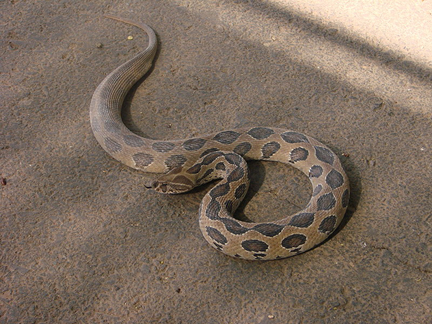
|
Green Defenders
Greendefenders
Illegal trading of Assam roofed terrapin
By-Prajakta Hushangabadkar
Recently we found Assam roofed terrapin (kachuga sylhetensis) in an aquarium shop. They sell it openly, they call it Singapore turtle and charge 700-1000 rupee for each turtle. Amravati, Pune and Mumbai are places where shop keepers sell it openly.
On the other hand, forest department and wildlife conservation activists are trying hard to protect this species. Assam roofed terrapin is protected under Indian wildlife protection Act 1972 and comes in schedule 1.
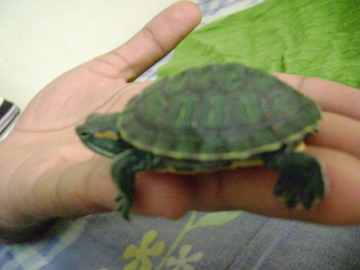
Assam roofed terrapin is literally unknown in the hills of Nagaland , Meghalaya and Bangladesh which is where it comes from. These turtles are small in size 180mm shell length, shell is olive-brown above and yellow –orange stripe along back of head and brown
spot on head. They are found in shallow water of river and feed on fish.
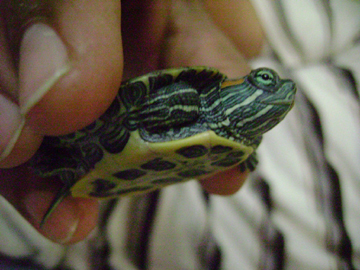
In black market they have special value as some people want terrapin with more number of fingers or nails for use of fenshuie, some time they ask for terrapin with two number head /mouth. Because of some vague belief in their powers, even orthodox people
are now days indulging in illegal trading of Assam roofed terrapin.
We are requesting all wildlife lovers and conservators to try to stop illegal trading of this turtle by informing your nearest forest department.
(photos by Prajakta Hushangabadkar)
If you know people and organization doing work for wildlife rescue and rehabilitation , share their achievements and work in wildlife conservation at green-defenders on Indian wildlife club mail us at prajakta.greendefenders@gmail.com and copy to susan_sharma@hotmail.com
|
Members Speak
We received 285 responses to the survey on Environment Education (
https://www.surveymonkey.com/s/2HHZM8W ).
81% agreed that learning in a community/club is less stressful. 80% of the respondents also agreed that the online content spurs them on to read more about issues which concern them.
Our archives of about ten years is now organized in a searchable format and relevant content is now retrievable fast.
Our recent addition of an individualised learning page
( http://www.indianwildlifeclub.com/UserProfile/My-Page.aspx )
for our members is a step taken in this direction. Searching on subjects of your interest or searchng on a subject title from the Environment education text book will give results which span all the archives of IndianWildlifeClub-Our e zines since 2001: chat
transcripts, press news, blogs etc.
Although there are text books on Environment Education which are introduced in schools and colleges and distance education courses available online and offline,
99%of our respondents agreed that environment education is a life-long learning process. 82% of the respondents also felt that environment education is best imparted in an
informal way.
A surprising result of the survey was that 64% of the respondents feel constrained when it comes to doing their bit towards environment. Out of this percentage group,43% felt constrained
while 21% felt constrained to some extent. This analysis is also supported by the large percentage of IWC members who have been using the feedback form on our website to say that they are looking for volunteering/employment
opportunities in the area of preserving our bio-diversity.
90% of those surveyed agreed that environment education must have a basis on field reports and scientific data. Considering that the large majority of IWC members are young and tech savvy, this result of the survey did
not come as a surprise. Corporates and government Babus who consider EIA (environment impact assessment) reports a mere formality, need to sit up and take note of this. This unmistakable confirmation for using field reports and scientific data as the basis
for any environmental action is also a wake -up call for our institutions and ministries which routinely take major decisions for political and individual gains.
Team IWC is working to get a project off ground to address the issues of constraints in working for nature and wildlife. Watch out for the initiation of the concept by means of an announcement on our home page.
-Susan Sharma
|
Nature and wellness
Greenery, health and poverty
-Sharada Balasubramanian
In urban India today, there are fewer parks and avenues for children to indulge in nature and activities like playing amidst greenery and trees. Unnatural surroundings in the recent past, has led to reducing the work of brains in human beings in the urban
areas, thanks to lack of trees. Unnatural surroundings affected our mental and physical health, and can powerfully alter how we think.
There is another important thing that needs to be thought about here. It is believed that living nears parks boosts health, irrespective of the social class one belongs to. Access to green spaces, it could be fields, or gardens, has an independent beneficial
impact on health. It also has an impact on health-related behaviour which counteracts the effects of poverty, according to research from scientists. The research established a link between serious illnesses and poverty. However, this is the first time that
scientists have shown systematically that the health gap between rich and poor can be halved with the help of green spaces.
In this research, the scientists have found the difference between those living in the greenest and least green areas was largest in death cases due to circulatory diseases.
Also, on the other hand, health issues like lung cancer has least impact of presence of greenery, predominantly because this is weakly linked to exercise. There was little space for the impact to happen.
These evidence show that there is a strong need for urban areas to retain and expand green spaces. The study was done by Richard Mitchell, of Glasgow University, and Frank Popham, of the University of St Andrews. They believe the planning authorities should
make green space available on grounds of health and well being of humans.
The scientists assessed the entire population of England under the retirement age, about 41 million people. They found out the cause of death for 366,348 people who died between 2001 and 2005. This was to analyze the links between fatal illnesses and access
to green spaces.
In their study, the found that “Populations that are exposed to the greenest environments have the lowest levels of health inequality related to income deprivation. Evidence suggests that contact with such environments has independent salutogenic effects, for
example, green spaces independently promote physical activity.”
"The implications of this study are clear: environments that promote good health might be crucial in the fight to reduce health inequalities."
Terry Hartig of the Institute for Housing and Urban Research at Sweden's Uppsala University writes: "This study offers valuable evidence that green space does more than pretty up the neighbourhood; it appears to have real effects on health inequality, of a
kind that politicians and health authorities should take seriously."

Sources:
http://www.childrenandnature.org/news/detail/study_finds_access_to_nature_increases_longevity
http://www.boston.com/bostonglobe/ideas/articles/2009/01/04/how_the_city_hurts_your_brain/
|
Nature and wellness
Nature and Happiness
-Sharada Balasubramanian
The birds around me hopped and played,
Their thoughts I cannot measure: —
But the least motion which they made,
It seemed a thrill of pleasure.
The budding twigs spread out their fan,
To catch the breezy air;
And I must think, do all I can,
That there was pleasure there.
If this belief from heaven be sent,
If such be Nature’s holy plan,
Have I not reason to lament
What man has made of man?
These are a few lines from the poem ‘Lines written in early spring’ by William Wordsworth- a poem that was inspired by nature and how small visions of nature can enthral and bring happiness in life.
It is believed that people who spend time with nature are more content and more happier individuals. They have a purpose, definition and direction to life, which in turn culminates into being a happy individual. In today’s world, the exposure to nature has
become narrow.
Modernity isn’t too monotonous, it’s too safe. It is said that by denying intimate contact with nature, modernity denies us contact with risk and thus, we are missing out on happiness as well.
Here is an interesting quote on nature and happiness:
“Nature is beauty. Lands, plants, animals, skies, and oceans are all a part of nature that is shared with us. Nature is so amazing because it doesn't need the assistance of man to continue surviving as it has done for so long. Nature's goodness can also make
up for all that is bad or wrong with man. Man destroys but nature creates and gives birth to. Nature is peaceful and content. It seems as if nature is the backbone to happiness. If there was no nature there would be nothing left in this world to admire and
cherish.”
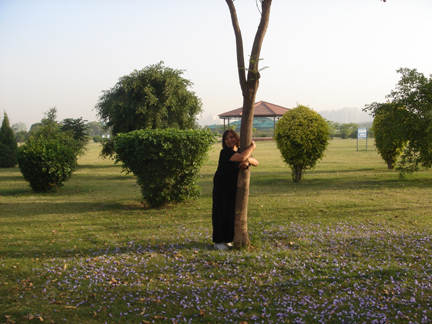
The loss of connect between urban humans and nature is be detrimental to health and happiness. It has been proved that green nature parks has a great ability of making people change into positive and happy people. Be being close to nature, observing them and
spending time in the green company can truly make us happy individuals.
References:
http://ecohearth.com/eco-op-ed/1163-is-nature-the-pathway-to-purpose-and-happiness.html
http://www.thehappinessinstitute.com/blog/article.aspx?c=3&a=1987
|
Poem
A Memorable Walk
-Bhakti Sharma
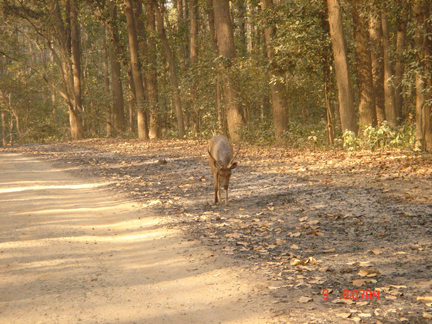
Walking down the forest path,
Me and you
Walking through
the rough terrain.
With uneven steps
On the mica,
Brighter than the silver
In the radiant light of the sun,
Filtering through
the tall majestic trees.
Fear of the wild pig,
the tiger and the bear,
Sometimes far,
At times near.
An exciting adventure
Filled our heart
With exotic fragrance.
The lake undisturbed
By the beasts peacefully resting,
The natural water spring
With its cold sweet water,
Gave some respite
To our fatigue and panting.
By Bhakti Sharma
|
Wild rescue
THE REPTILE RESCUE SQUAD-COBRA
by
Aditi Baindur
The phone rang, it was Abhinav Chawla Uncle to speak to Dad! But Dad was out walking the dog! Abhinav Uncle told me that there was a cobra in his room. When Dad got back, I once again pleaded to come along reminding him of how I had helped him rescue the Russell's
Viper.
Reluctantly he agreed but ONLY if I obeyed him without exception. Gathering our kit, we got into our car and reached Chawla Uncle's room next to the tennis courts. Chawla Uncle was standing outside adjusting his camera and his lenses - he is a very enthusiastic
photographer. Apparently Chawla Uncle's passion for photography was known to the
subordinate staff, one of whom had caught a baby cobra and brought it to him for photography, no doubt excepting some "traditional" fauji appreciation.
The basket he brought it in was one of the fruit baskets made of thin bamboo slats and which had disintegrated with the cobra inside it. The basket was intact with the snake trapped in it but lifting it or moving it would most probably cause it to fall apart
and the baby cobra to escape. Chawla uncle needed Dad's help to photograph and then release the snake.

Baby Cobra seen from the side
Image credit - Abhinav Chawla
Now, baby snakes are delicate. A hard grip can easily damage their slender jaw bones or their soft internal organs with a lingering painful death following. Yet a baby cobra is venomous from the moment it is born, a miniature version of its parents. Now dad
is unfazed by large, strong snakes but handling a juvenile venomous snake calls for a different set of technique. So we did what every person who is out of his depth should do - call in an expert. In this case, the expert was Dad's good friend Col Christopher
Rego who is posted in the Bombay Sappers. Dad and Chris Uncle were YOs room-mates.
Chris Uncle came onto the scene - fortunately he was free that evening.We procured another basket while he was on the way - this time akin to those used by snake charmers.
Chris uncle took the bottom half of the snake charmer's basket and reverted it on a piece of cardboard. He then had it propped open with a shoe and slid it close to the fruit basket now on its last legs. He offered the entrance under this basket as a new sanctuary
for the
snake while disturbing it from the other end with a snake stick. The baby cobra bought the trick and slid under the new basket. Then uncle flipped the cardboard over and placed the top cover before the infant realised what was happening.
We then took the baby cobra to the Demolition ground where the snake could not escape and adequate safety distances are available. Contrary to urban legend, man can easily outrun snakes. Here Christopher Uncle showed Dad and Chawla Uncle the correct technique
to catch baby cobras without endangering oneself and without hurting it. Then we released
the baby snake in the marshes near where the Water Plume is shown and it immediately swam into a large puddle and entered a hole just to be sure we could not recaptue it again.
|
Wildlife Photolog
Meeting Blackbucks, the sweetest ones, in Velavadar, Gujarat
By
Ajay Jain
As far as sanctuaries go, Velavadar in Gujarat is the sweetest one. It is home to Blackbucks, beautiful members of the deer family. But don’t let the gentle beauty of Blackbucks fool you. They always take home the silver medal in running events, clocking speeds
upto 80 kmph (50 miles per hour). Only the Cheetah pips them to the post. Velavadar has the highest concentration of the endangered Blackbuck anywhere.
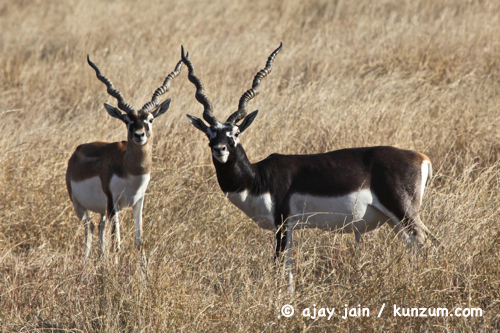
Mature male Blackbucks, distinguished by horns and a darker skin
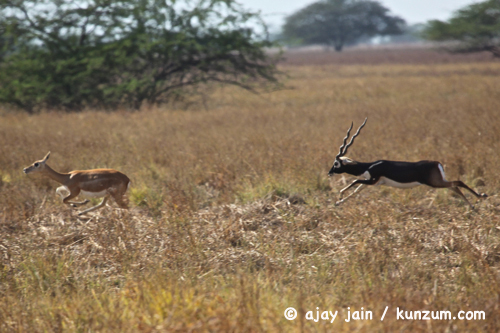
A male Blackbuck chasing a female. Will he get her? I happened to call upon the Blackbucks during their peak fawning period of March - April (the other being September - October), and such sights were quite common.
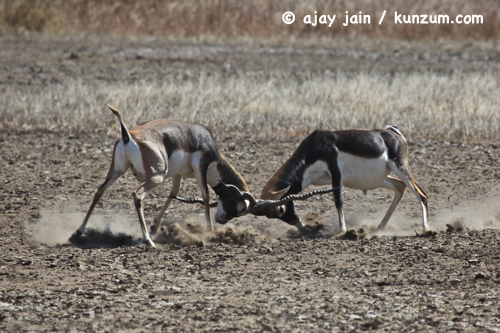
Two male Blackbucks locking horns, possibly over the right to win a female. When the males are not mating, they are locking horns to get the women for themselves. More than a pair were spotted fighting by me. Each male
has its territories, but we know how politics works. But do they really need to spar? It seemed there were more than enough females going around for all. But then again, men will be men.
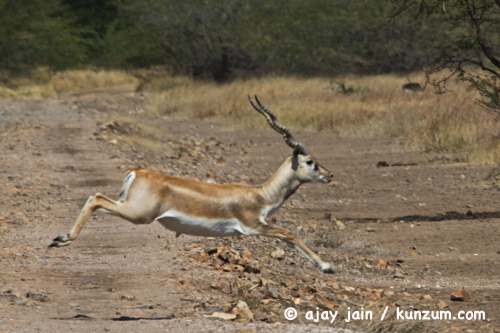
A female black buck fleeing; I could have looked at Blackbucks for hours. Even they would not stop looking at me - curious about the Martian in their land. But a single step in their direction, and they would flee.
The open grasslands of Velavadar suits the blackbucks just fine. They have a life span of up to 15 years, can be 120 cm long with shoulder heights of 73-83 cm and weigh between 32-42 kilos. Since there are no big cats here, all animals are relatively safe here
and their tribe is only increasing.
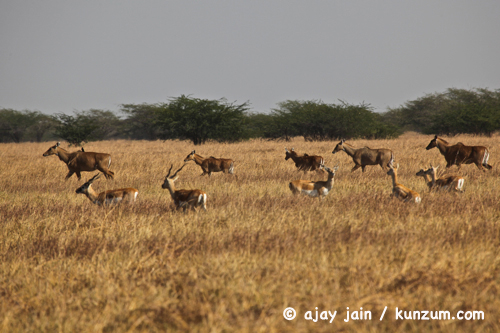
A group of female Blackbucks and Antelopes fleeing as I got closer.
Ajay Jain is a travel writer and photographer and shares his stories on www.kunzum.com. He can be contacted at ajay@ajayjain.com
A bit about Blackbuck National Park, Velavadar, Gujarat
If you are planning to go to Velavadar, here is some useful information for you.
* Distance from Ahmedabad: 200 kms (125 miles).
* Distances from other places: Bhavanagar (52 kms), Palitana (110 kms), Lothal (125 kms), Alang (107 kms). Do check these for sure, I have taken these from official brochure.
* Safaris: You have to take your own vehicle, the park does not have any. Or ask your hotel to arrange one. Guides are usually available for a nominal fee, but some of them go off for farm work during low season. The official at the entrance will help you call
them on their mobiles.
* When can you visit: The park is open from sunrise to sunset. It closes from June 16 - October 15 for the rainy season.
* Where to stay:
(a) The best option is The Blackbuck Lodge, a wonderful property a mile from the park gate. Contact them at www.blackbucklodge.com / reservations@theblackbucklodge.com / +91.9228000496 / +91.9825161212 / +91.79.40020901 / +91.9824019877.
(b) Alternately, you can stay the Forest Department Guest House within the park. They have 4 rooms. Contact for booking:
Assistant Conservator of Forests, Blackbuck National Park, Velavadar-Bhal, F-10, Annexe, M.S. Building, Bhavnagar;
+91.278.2426425. The Range Forest Officer at the park can be contacted at +91.278.2920222. Room charges are Rs. 1,500 (US$ 75 for foreigners) for air-conditioned rooms; Rs. 500 (US$ 50) for non-AC; Dormitory per person: Rs. 50 (US$ 10); Tent (per
tent): Rs. 200 (US$ 20)
The only other stay options are at towns close by.
* Entry Fee (brackets give fee for non-Indians in US$, but paid in Rupee equivalent):
Adult: Rs. 20 (US$ 5) Children (3-12 years): Rs. 10 (US$ 5)
Students on Educational Tour: Rs. 10 (US$ 5) Vehicle Fee (for upto 6 persons): Rs. 200 (US$ 20)
Vehicle Fee (for upto 15 persons): Rs. 500 (US$ 50)
Vehicle Fee (for capacity upto 60): Rs. 1750 (US$ 175)
Guide Fee: Rs. 50 (US$ 10) for first 4 hours; Rs. 20 (US$ 5) for every subsequent hour. But you can pay more if it pleases you.
The fee is for a full day and you can go in and out as you like.
|